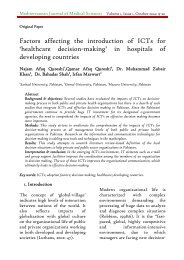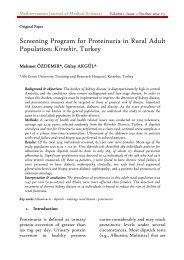Screening Program for Proteinuria in Rural Adult Population: Kirsehir, Turkey
Background & objectives: The burden of kidney disease is disproportionately high in central Anatolia, and the conditions often remain undiagnosed until late-stage disease. In order to reduce this burden, strategies must be implemented to improve the detection of kidney disease, and preventative measures must be targeted at those at greatest risk of disease. Important risk factors among include hypertension, diabetes, and obesity. As the exact prevalence of proteinuria is not known in the general population, we undertook this study to estimate the same in a rural adult population in Kirsehir district. Methods: A survey of health and health related issues was conducted on 2524 volunteers, average age 52.19 years, selected randomly from the Kirsehir District, Turkey. A dipstick urinalysis and test for Proteinuria was performed on a clean void, untimed urine sample as a part of a 4-hour interview/examination. Ultrasound of the abdomen was done in patients with renal failure and renal biopsy was performed in selected patients. Results: Of the total 2524 individuals screened, 61.3 per cent were females. Mean age of the study population was 51.19 ± 11.2 yr. First dipstick test identified 289 individuals positive for albuminuria. Repeat dipstick could be done in only 263, of whom 117 showed persistent albuminuria. Significant proteinuria was detected in 14 individuals of the 208 who had 24 h urine protein measured. Of these 14 patients, 3 were found to have chronic renal failure, 6 were presumed to have diabetic nephropathy clinically, one each had focal segmental glomerulosclerosis and biopsy proven diabetic nephropathy, and 4 patients had proteinuria of unknown aetiology. Interpretation & conclusion: The prevalence of proteinuria in this adult rural population was 0.47 per cent (0.30-0.67%) and Males were more affected than females. The detection and treatment of chronic kidney disease in 14 individuals is bound to reduce the rate of decline of renal functions. Key words: Albuminuria - dipstick - endstage renal disease - proteinuria
Background & objectives: The burden of kidney disease is disproportionately high in central
Anatolia, and the conditions often remain undiagnosed until late-stage disease. In order to
reduce this burden, strategies must be implemented to improve the detection of kidney disease,
and preventative measures must be targeted at those at greatest risk of disease. Important
risk factors among include hypertension, diabetes, and obesity. As the exact prevalence of
proteinuria is not known in the general population, we undertook this study to estimate the
same in a rural adult population in Kirsehir district.
Methods: A survey of health and health related issues was conducted on 2524 volunteers,
average age 52.19 years, selected randomly from the Kirsehir District, Turkey. A dipstick
urinalysis and test for Proteinuria was performed on a clean void, untimed urine sample as a
part of a 4-hour interview/examination. Ultrasound of the abdomen was done in patients
with renal failure and renal biopsy was performed in selected patients.
Results: Of the total 2524 individuals screened, 61.3 per cent were females. Mean age of the
study population was 51.19 ± 11.2 yr. First dipstick test identified 289 individuals positive for
albuminuria. Repeat dipstick could be done in only 263, of whom 117 showed persistent
albuminuria. Significant proteinuria was detected in 14 individuals of the 208 who had 24 h
urine protein measured. Of these 14 patients, 3 were found to have chronic renal failure, 6
were presumed to have diabetic nephropathy clinically, one each had focal segmental
glomerulosclerosis and biopsy proven diabetic nephropathy, and 4 patients had proteinuria of
unknown aetiology.
Interpretation & conclusion: The prevalence of proteinuria in this adult rural population was
0.47 per cent (0.30-0.67%) and Males were more affected than females. The detection and
treatment of chronic kidney disease in 14 individuals is bound to reduce the rate of decline of
renal functions.
Key words: Albuminuria - dipstick - endstage renal disease - proteinuria
Create successful ePaper yourself
Turn your PDF publications into a flip-book with our unique Google optimized e-Paper software.
Mediterranean Journal of Medical Sciences V1, I1 October 2014: 1-5 4<br />
were away from home at work<br />
dur<strong>in</strong>g the time of sample<br />
collection. Among the various<br />
aetiological factors, diabetic<br />
nephropathy was found <strong>in</strong> 7 of 14<br />
patients (50%) with prote<strong>in</strong>uria.<br />
Seven patients with significant<br />
prote<strong>in</strong>uria not meet<strong>in</strong>g the<br />
criteria <strong>for</strong> a renal biopsy are<br />
be<strong>in</strong>g followed up. Patients with<br />
diabetic nephropathy were<br />
advised euglycaemic measures and<br />
are on follow up with the health<br />
department. One <strong>in</strong>dividual with<br />
focal<br />
segmental<br />
glomerulosclerosis was treated<br />
parts of the country may prove to<br />
be an effective measure <strong>in</strong><br />
reduc<strong>in</strong>g the burden of chronic<br />
kidney disease.<br />
Acknowledgment<br />
The authors thank tra<strong>in</strong>ed health<br />
care workers at Ahi Evran<br />
University Tra<strong>in</strong><strong>in</strong>g and Research<br />
Hospital, <strong>Kirsehir</strong>, <strong>Turkey</strong> <strong>for</strong><br />
their assistance <strong>in</strong> per<strong>for</strong>m<strong>in</strong>g<br />
ur<strong>in</strong>e dipstick exam<strong>in</strong>ation.<br />
Table 2. Prevalence rate of prote<strong>in</strong>uria (%) accord<strong>in</strong>g to age and gender<br />
Age Males Females<br />
(yr) (N) Prevalence (N) Prevalence<br />
40-59 621 0.60 (0.58 - 0.62) 1050 0.62 (0.61 - 0.64)<br />
60-79 319 0.32 (0.30 - 0.34) 441 0.35 (0.347 -0.349)<br />
>80 36 0.07 (0.06 - 0.09) 57 0.03 (0.027 -0.029)<br />
Total 976 1548<br />
Values <strong>in</strong> parentheses <strong>in</strong>dicate range<br />
with ACEi and has stable renal<br />
function. The risk of renal failure<br />
is greater <strong>in</strong> younger patients.<br />
In conclusion, although the<br />
prevalence of prote<strong>in</strong>uria <strong>in</strong> this<br />
rural population was low,<br />
detection and treatment of chronic<br />
kidney disease <strong>in</strong> 14 <strong>in</strong>dividuals<br />
with prote<strong>in</strong>uria is likely to reduce<br />
the rate of decl<strong>in</strong>e of renal<br />
function. Similar screen<strong>in</strong>g<br />
programmes <strong>for</strong> prote<strong>in</strong>uria with<br />
proper study design <strong>in</strong> different<br />
References<br />
1. Nakopoulou L, Stefananki K, Papadakis<br />
J,Boletis J, Zeis PM, Kostakis A et<br />
al. Expression of bcl-2 oncoprote<strong>in</strong><br />
<strong>in</strong> various types of<br />
glomerulonephritis and renal<br />
allografts. Nephrol Dial Transplant<br />
1996; 11: 997–1002<br />
2. Gerste<strong>in</strong> HC, Mann JF, Yi Q, et al.<br />
Album<strong>in</strong>uria and risk of<br />
cardiovascular events, death, and<br />
heart failure <strong>in</strong> diabetic and<br />
nondiabetic <strong>in</strong>dividuals. JAMA 2001;<br />
286 : 421-6.<br />
©2014 Mediterranean Center of Medical Sciences








